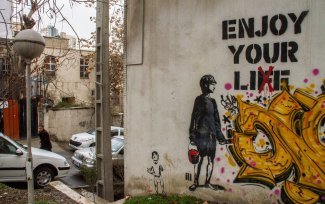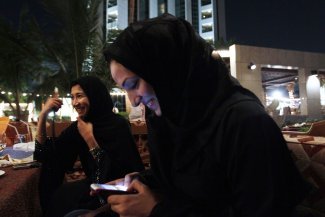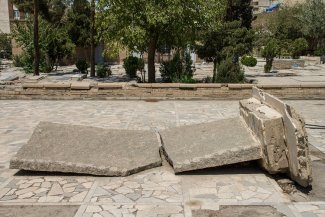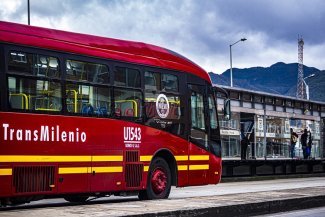In this photo taken in downtown Yerevan on 26 November 2021, a sign in Farsi reads: “Massage salon. Free alcoholic drinks. Free hooka.”
Abdi (not his real name) slows down at the entrance of a building just off the bustling Aram Street at the centre of the Armenian capital, Yerevan. On the top of the building’s glass door, a massive sign in English reads: ‘Children of Armenia Fund’. Inside, a formally dressed crowd participates in an event; outside, Abdi enquires curiously through the glass windows, attempting to figure out what is happening there. Finally, after reading the English sign, his eyes blaze with hope, and he asks: “What kind of organisation is this? Can I apply for a fund?”
Abdi, 45, a father of three, was a teacher with a permanent job in the Iranian city of Karaj. Then, in October 2021, he left everything behind and moved to Armenia, escaping Iran’s economic crisis and dictatorial regime. In Armenia, he enrolled in a dental school at one of the many universities offering courses in English. Since then, he has been looking for any source of income that could let him bring his family to Yerevan, a city still suffering from the economic and political impacts of the 2020 war in Nagorno-Karabakh, which rumbles on as an ongoing conflict with Azerbaijan.
It is not the quality of higher education or more affordable tuition fees that brought Abdi to Armenia. The best university in Armenia, Yerevan State University, is placed 2641 on the Ranking Web of Universities index, while Iran has 54 universities ranked between 309 and 2635. Abdi is one of the over 3,000 Iranian students who moved to Armenia, hoping they would have a better chance to migrate to countries in the Global North, if they spend a few years in this mountainous country in the South Caucasus.
In search for a better life
“I’m done with my life,” Abdi explains during one of his long walks in central Yerevan, the cheapest entertainment he has found in the city. “My generation’s life was wasted in the Islamic Republic, but I don’t want my children to go through the same experience.”
Just before the pandemic, Abdi was accepted to a PhD program in Spain. Still, then most universities offered distance learning to international students, and he lost the chance to go to Europe and seek “a better life” there. So, he changed his plans and chose Armenia, an easy-to-reach destination for Iranians. Living expenses are cheaper than in Europe in Armenia, and Iranians can enter it without a visa.
“Armenia is not a European country, but still, it is much better than Iran. I don’t want my daughter to grow up under strict Islamic laws, forced to put on a hijab and take religious courses at school. I hope that eventually she can live and study in the West,” he tells Equal Times.
Like Abdi, many other Iranians have ended up in the Armenian capital in the past decade. Those who cannot find a direct path to legally migrate to the countries like the United States, Canada and the United Kingdom choose Armenia as a temporary migration destination. Although no official data about the exact number of Iranians living in Armenia is available, it is inescapable to hear conversations in Farsi on Yerevan’s Soviet-style streets.
As demonstrations against the obligatory hijab and a deadly crackdown on dissidents continue in Iran, it is expected that the number of educated and skilled worker migrants from Iran will increase in the coming months. This pattern of immigration has occurred after all significant social movements in Iran, in 1999, 2009 and 2019.
In Yerevan, at every corner of the city centre, big signs in Farsi advertise accommodation, food, tours or even money transfers between Iran and Armenia – despite international sanctions banning Iranians from transferring money to and from their country.
Some Iranians who arrived in the land of Armenians in the past years have eventually made it their second home. One of those is Hamid, 53, a former insurance officer.
In 2011, he shut down his insurance office, sold everything he had and began his search for a new life. First, he went to Malaysia, hoping to receive permanent residency through an investment programme, but it was all in vain. Then, he headed to the other side of the world and landed in Brazil with the same goal. Unsuccessful again, and with not much money left in his pockets, Hamid finally settled in Armenia in 2014.
Now, he runs a small stall in Yerevan’s well-known Vernissage flea market, where he sells the artisanal handicrafts that his wife makes. With this small business, Hamid raised his two sons and now both of them are studying at a university in Germany.
“I’m happy they made it to Europe,” he says as he displays necklaces and bracelets with embroidered flowers. “I couldn’t make it to Europe, but if my sons manage to live there, maybe my wife and I could also go there and spend our retirement time with them,” he adds, with a faded smile on his face as if he himself does not believe his dream could come true.
For him, the social freedom and security he has gained in Armenia are the main reasons to live in a country with a different language and religion.
“I feel comfortable here. The Armenian people are kind, and because of their historical background, they understand what it means to leave your homeland and search for a safe place to live,” he continues, referring to the Armenian genocide, during which nearly one million Armenians were killed by the ruling nationalist government of the Ottoman Empire during World War One.
Big fun on a little budget
But, not all Iranians in Armenia seek a calm life or a bright future for their children.
“What Iranians want is to party,” says Khachatour Harounyan, a tourism advisor in Yerevan who has worked with Iranian tourists for the past five years.
Harounyan explains that Iranian holidaymakers provide an essential boost to Armenia’s tourism industry, as they are among the top four groups of visitors to Armenia – after Russians, European Union residents, and Americans. However, most Iranian tourists only spend their time and money in the capital Yerevan.
“It’s rare to see Iranian tourists in any city other than Yerevan. They would approximately make a day trip to Lake Sevan in the summer. In Yerevan, most Iranians enjoy themselves buying booze from the supermarkets, drinking in hostels, or going to Iranian nightclubs,” Harounyan adds.
According to him, these tourists have a very tight budget because of the devaluation of their currency. Since 2018, Iran’s currency has lost over 70 per cent of its value due to US sanctions. But still, every year, thousands of Iranians travel to their neighbouring country, Armenia.
Armenia might be an unknown holiday destination for many tourists globally, but not for Iranians. In 2016, the two countries scrapped all requirements for a 90-day visa for their nationals. So, for Iranians who can hardly ever obtain a tourist, work or study visa to other countries, Armenia is heaven. However, the cost of travelling to this heaven have sharply increased since the beginning of the war in Ukraine because many Russian citizens have escaped to Armenia to partial mobilisation of former military personnel to fight the war in Ukraine.
Iranians do not care that in 2019, Armenia was ranked 79th out of 140 countries on the World Economic Forum’s Travel & Tourism Competitiveness Report. As far as they can escape from their homeland’s strict Islamic laws and harsh punitive measures, they will continue travelling to this developing country, spending a week or two in its capital, wandering half-drunk through its streets.
Leyla and her boyfriend Ali, both professionals in their mid-30s, travelled to Yerevan for a ten-day vacation to take a short break from Iran. Even though drinking on the streets is forbidden in Yerevan, they walk arm in arm with bottles of beer in their hands through Yerevan’s Republic Square.
“What will the police do to us?” asks Leyla unmoved by the possibility of punishment. “Give us a fine? I will happily pay that fine. We would be flogged in Iran if were arrested because of drinking, even inside of our home.”
With the same goal of “experiencing a bit of freedom”, Shafi, a 25-year-old firefighter, made the more than 2,000-kilometre trip to Yerevan to – as he puts it – “see what Europe looks like”. He started his journey from the port city of Bushehr, on the Iranian side of the Persian Gulf. He paid about US$15 to take a domestic flight to Tehran and then a bus to Yerevan. Shafi spent four days on the way and two nights in Yerevan.
He only had one week of vacation, and instead of Armenia, he could, with a small ship, have travelled to Dubai on the other side of the Persian Gulf. But a one-week journey to Dubai would cost him ten times more than travelling to Armenia.
“In Dubai, you see more or less the same landscape and people as we have in Iran,” he says. In the Armenian capital, he climbs up the limestone stairways at the Cascade Complex, carrying in one hand a bottle of vodka hidden in a dark plastic bag. When Shafi stops to take a sip from the bottle and get his breath back, he satisfyingly says: “Here looks like Europe. Look at all these brand-new cars! Look how women don’t cover their heads! It’s beautiful!”












